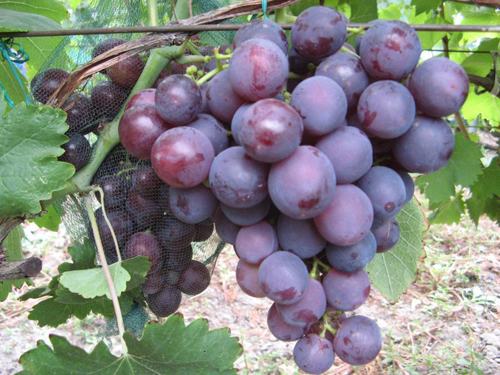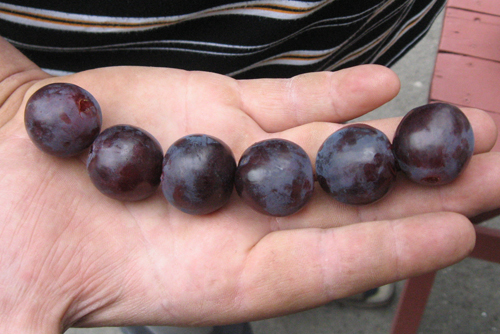Rochefort grape variety
The table grape variety Rochefort is one of the many novelties of the master of folk selection Evgeny Georgievich Pavlovsky from Novoshakhtinsk, Rostov region of the Russian Federation. For the former miner, the creation of new varieties of solar berries became a matter of life after meeting the famous scientist from the Novocherkassk Scientific Research Institute of Viticulture and Winemaking Ivan Kostrikin. He spoke about the main intricacies of the process of crossing varieties, sowing, selection and reproduction of the resulting hybrid material. This story, and then the first positive personal experience, so inspired Pavlovsky that since then he cannot imagine himself without research work, endowing winegrowers with new hybrid forms with completely different colors, sizes, tastes and aromas of berries. Many of them turn out to be so successful that they not only instantly turn out to be hits among amateurs, but also receive recognition at the highest level, officially entering the State Register of Breeding Achievements of the Russian Federation.

One of these, which has earned official approval for cultivation on the territory of the country, is the dark-colored early-ripening variety Rochefort. It came from one of the beloved parental pairs used by the breeder in his work: grapes were chosen as the mother form Mascot, and the paternal - Cardinal mixed with pollen of other species. The choice was not accidental, and more than once showed an excellent result with Pavlovsky. The talisman in this pair is the donor of disease resistance, large-fruited and general unpretentiousness, and the Cardinal is responsible for early maturity, high palatability of the fruit and the attractive appearance of the bunch. Rochefort, to a certain extent, combined all these qualities in himself, and appeared to the court of winegrowers with a whole range of positive characteristics, both aesthetic and agronomic. He has a remarkable in appearance bunch, very reminiscent of an enlarged "cardinal" one, and at the same time much less susceptibility to diseases and pests than the Cardinal, and an order of magnitude better frost resistance.
It is thanks to all these properties, as well as the very early ripening period, that the army of fans of the variety is steadily increasing, despite the very short time that has passed since its appearance.
Agrobiological characteristics
Rochefort bushes are vigorous, vigorous, growing wood well. The leaves of the grapes are large, rounded, five-lobed, rich green in color. The surface of the leaf is reticulate-wrinkled, the reverse side is covered with very weak cobweb pubescence. The first leaves on the shoot are almost whole, the next ones are medium dissected. The upper lateral notches on the dissected leaves are deep, open, lyre-shaped with a narrow aperture and a rounded bottom, the lower ones are barely outlined or absent altogether. The petiole notch is open, vaulted, of medium width, with a pointed bottom. The denticles along the edge of the leaf blade are dome-shaped, moderately large, with a wide base, convex edges and a pointed apex. The flowers of the variety are bisexual, as a rule, they are well pollinated with their own pollen, however, under adverse weather conditions during the flowering period, cases of insufficient pollination are possible, due to which the bunch may be too loose, and the berries may be pea. Young shoots have a light green color, gradually darkening, and in a mature state they acquire a brown color. The maturation of one-year growth is good - more than 2/3 of their length.

Bunches of grapes are very large - from 500 to 1200 grams, conical or cylindro-conical, medium density, sometimes loose. The size of the Rochefort brushes may vary depending on the rootstock. The most modest in size clusters grow on self-rooted bushes, the largest - in a grafted culture on vigorous rootstocks.The correlation of the size of bunches and berries with the age of the plant was also noted - the older it is in age and the more it accumulates perennial wood, the more large-fruited it becomes every year. The comb is long, strong and branched, light green in color. The berries are large, round, up to 26 × 28 mm and weighing up to 13 grams. The size of the grapes in a bunch is not always aligned: often, along with gigantic grapes, there are also small grapes, which can somewhat spoil the presentation of the crop. The shape of the berries is round, the color varies from red-gray to almost black. The difference in morphological traits is due to some genetic instability and the current presence of several clones of this variety with slightly different characteristics. The pulp of the fruit has a consistently pleasant consistency, crisp and juicy, with a good harmonious taste and light nutmeg aroma. The juice of ripe grapes is colorless with a sugar content of 14-17 grams / 100 ml, acids - 5-7 grams / liter. The skin is quite dense, but when chewed, it is fragile and eaten. The outside is covered with a medium-intensity gray waxy bloom. There are 2-3 seeds in the berry, their size is average, they almost do not spoil the taste characteristics. The tasting score according to the results of the state variety test is very high - 9.7 points, better than even that of many seedless varieties.
Rochefort is great for fresh consumption, but it is also suitable for making delicious and elegant compotes and preserves. Large, intensely colored clusters have an excellent presentation and invariably arouse the interest of buyers. For this reason, the variety is undoubtedly considered "marketable", the main thing is to prevent insufficient pollination and a decrease in commercial qualities due to this. Thanks to the dense pulp and skin of the berries, it perfectly tolerates transportation over long distances. For the same reasons, it can be stored well in refrigerated chambers for several weeks.
Removable ripeness is very early. The grapes are ready for harvest on average 110-120 days after the buds awaken. For ripening, it needs relatively little summer heat - in the amount of 2300-2400 ° C of active temperatures. This allows you to cultivate it without problems in the middle lane, provided that the vines are protected from winter frosts. The lowest temperature that Rochefort can withstand during the cold season is -21 ° C. Its frost resistance is not bad for traditional wine-growing regions, but, nevertheless, it does not allow growing it without shelter in all those climatic zones where the grapes themselves have time to ripen.

The yield of the variety is very high. During the test for the right to be included in the State Register of Breeding Achievements, he showed an impressive result of 173 c / ha. Individual bushes, after entering fruiting, consistently yield from 8 kg of grapes, gradually increasing this indicator every year. High productivity is due to a significant percentage of fruitful vines on the bush and the large size of the bunches growing on them. At the same time, more than one brush is often laid on the fertile shoots of Rochefort, and if no measures are taken, this can cause plant overload, lengthen the ripening period and reduce the quality of the crop.
After ripening, the bunches can continue to hang from the bushes due to their low susceptibility to pest damage, cracking and decay of the berries. Only when extreme drought changes with torrential rains, or a very damp and cold summer, are these problems possible. Wasps, on the other hand, almost never annoy, thanks to the rather strong skin of the grapes.
Agrotechnical features
Evaluating Rochefort from the point of view of unpretentious cultivation, first of all, it is worth noting that, in comparison with the parent variety Cardinal, it shows much less effeminacy, but, of course, does not reach the complex-resistant forms. This grape is characterized by average resistance to fungal diseases and winter hardiness, not always satisfactory fruit set and the tendency to overload the crop, which is common for large-fruited hybrids.The listed factors determine the strategy of the grower approach to this variety, requiring the enterprise to take measures to level these specific features in his agrobiology.
To combat diseases, it is necessary to clearly define the periods of their greatest harmfulness and carry out chemical treatments at this particular time. Mandatory spraying of Rochefort from mildew and oidium is required before and after flowering, and during the growing season, repeat them as needed in the case of the first manifestations of the disease noticed on grapes. To do this, of course, you need to have at least a basic understanding of the symptoms of the development of certain pathogens. The result of this approach will be significant savings on the purchase of fungicides, reducing their load on the vineyard, and, consequently, increasing the environmental friendliness of the resulting crop.
Protection of the variety from frost, where it is needed, should be carried out using a standard, but rather laborious technique - removing vines from the trellis in autumn and warming them. Only in the very south, where the risk of a temperature drop below -21 ° C is low, can Rochefort be cultivated in an open culture on a high stem. This form of bush management will allow the plant to accumulate significant volumes of perennial wood, which will best affect its yield and presentation of the grapes. In less favorable climatic conditions, you will have to choose more compact squat formations in order to be able to cover the bushes. The thickness of the insulating layer can also vary depending on the minimum possible temperatures in winter. In the harshest places, you will need to work hard to create a high-quality two-layer shelter, while in less frost-prone regions, one layer will be enough. In both cases, the main thing is to prevent the vine from getting wet during the wintering process, which requires not only insulation, but also a waterproofing layer on top of it.
To prevent overloading of plants with shoots and crops, it is necessary to carefully ration them, both during spring pruning and during the growing season. The recommended load on an adult fruiting bush of this variety is 30-35 eyes with an average pruning length (6-8 buds). After the start of the growth of grape shoots, their number must be adjusted at the rate of 3-4 pieces per square meter of the feeding area of the bush. In other words, with a planting scheme, for example, 3 × 2 meters (feeding area 6 square meters), 22-24 strong fruit-bearing shoots should remain on the Rochefort bush after fragments. In addition, on each of them, after thinning the brushes, no more than one should remain, and only then can you be sure that the load is completely regulated, and the plant will not experience difficulties in the process of growth and ripening of fruits.
Finally, you need to take care of improving the pollination of flowers in unfavorable seasons for this. A positive effect in this is the early removal of leaves in the fruit zone, which contributes to better ventilation of the inflorescences and, accordingly, the setting of berries. In addition, such an event also gives a positive effect in the fight against diseases, allowing plant protection products to freely fall on the brush during treatments. And during the ripening period of the grapes, the absence of leaves around the bunches will have a positive effect on their appearance, the accumulation of sugar and the strengthening of the aroma due to the greater amount of sunlight falling on them. And then your Rochefort will turn out to be just as tasty and attractive as the author created it.








